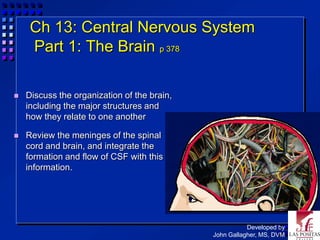
Chapter13 cns part1marieb
- 1. Ch 13: Central Nervous System Part 1: The Brain p 378 Discuss the organization of the brain, including the major structures and how they relate to one another Review the meninges of the spinal cord and brain, and integrate the formation and flow of CSF with this information. Developed by John Gallagher, MS, DVM
- 2. Ventricles of the Brain p 381 CSF filled chambers Communicating with central canal of spinal cord Lined by ependymal cells Central Canal of Spinal Cord Fig 13.9
- 3. Four Major Brain Subdivisions 1. Brain Stem a. Medulla oblongata b. Pons c. Midbrain 2. Cerebellum 3. Diencephalon a. Hypothalamus b. Thalamus c. Epithalamus 4. Cerebral Hemispheres AKA Cerebrum Fig 13.11
- 4. 1) Brain stem a. Medulla oblongata b. Pons c. Midbrain • Location of autonomic nuclei involved in respiratory and cardiovascular control • Relay stations for sensory and motor neurons • Decussation
- 5. 1a) Medulla oblongata Pyramids – Motor output to spinal cord – Decussation Reticular formation – Lower functions – Respiration, sleep, etc. Cranial nerves – VIII, IX, X, XI, XII
- 6. 1b) Pons Pons = bridge Connects to cerebellum – Via cerebellar prduncles Cranial Nerves – V, VI, VII
- 7. 1c) Midbrain Cerebral aqueduct – Old term: Aqueduct of Sylvius Several nuclei (ganglia) – Substantia nigra Sensory reflexes – Aural, visual
- 8. 2) Cerebellum Dorsal to the Pons Two hemispheres – Connected by the vermis Maintains posture and equilibrium – Smooths motor activities – Some cognitive function Cortex - gray surface – Purkinje cells (p 354), axons of which become arbor vitae (white matter) in center » Large cell bodies visible in gray matter of cerebellum » Use GABA as NT » Motor output from cerebellum White matter: Arbor Vitae
- 9. 3) Diencephalon p 390 3a. Hypothalamus 3b. Thalamus 3c. Epithalamus
- 10. 3a. Hypothalamus Just superior to optic chiasma Infundibulum - connects to pituitary gland Some functions: – Control of autonomic nervous system – Coordination of nervous and endocrine systems – Manufacture of hormones - ADH and oxytocin (Ch 17)
- 11. 3b. Thalamus (80% of diencephalon) Next to 3rd ventricle Communication with hemispheres
- 12. 3c. Epithalamus – Pineal gland - produces melatonin, – sets diurnal cycles – Choroid Plexus – produces CSF
- 14. 4) Cerebrum (Telencephalon) 83% of total brain mass The right and left halves (cerebral hemispheres) – are separated by the Longitudinal Fissure – and connected by the Corpus Callosum and Anterior Commissure – are separated from the cerebellum by the transverse fissure Sulcus and Gyrus – Central Sulcus Gray Matter vs. White Matter The cortex (gray matter) of the cerebrum is the site of conscious thought
- 15. 4) Cerebral Hemispheres, cont’d . . have functional regions – Sensory and motor areas » e.g. Broca’s area (speech) – Prefrontal Cortex (Cognitive functions) . . . have some functional differences (in spite of anatomical resemblance) → Lateralization of cortical functioning – Right brain: artistic skill – Left Brain: math, logic . . . receive sensory information and generate commands for opposite side of body – Decussation of sensory input is in the spinal cord – Decussation of motor output is in the pyramids
- 16. Fig 13.18
- 17. fMRI An fMRI of the brain. Green areas were active while subjects remembered information presented visually. Red areas were active while they remembered information presented aurally. Yellow areas were active for both types.
- 18. 4) Cerebrum, cont’d Regions of the Cortex Lobes named after the bones of the calvarium Sensory vs. Motor Areas – Homunculus Gyrus and Sulcus – Central Sulcus
- 19. 4) Cerebral Cortex and Central White Matter Gray surface (cortex), 2-4 mm thick, is mostly neuron cell bodies with white tracts internally Projection tracts (fibers) – connect more or less vertically Association tracts (fibers) – connect one gyrus to another in the same hemisphere
- 21. Basal Ganglia p 402 More proper term: basal nuclei A collection of several nuclei Gray matter deep to the cerebral cortex, below floor of lateral ventricles. Function: modulate motor output from the cerebral cortex. Subconscious control of skeletal muscle tone and coordination of learned movement patterns. Parkinson's disease is caused by the loss of at least 80% of the dopaminergic neurons in basal nuclei and substantia nigra of the midbrain (resting tremor)
- 22. Gray & White Matter Organization In brain stem similar to spinal cord (nuclei around ventricles, tracts on outside) In cerebrum and cerebellum: white matter covered with layer of neural cortex (grey)